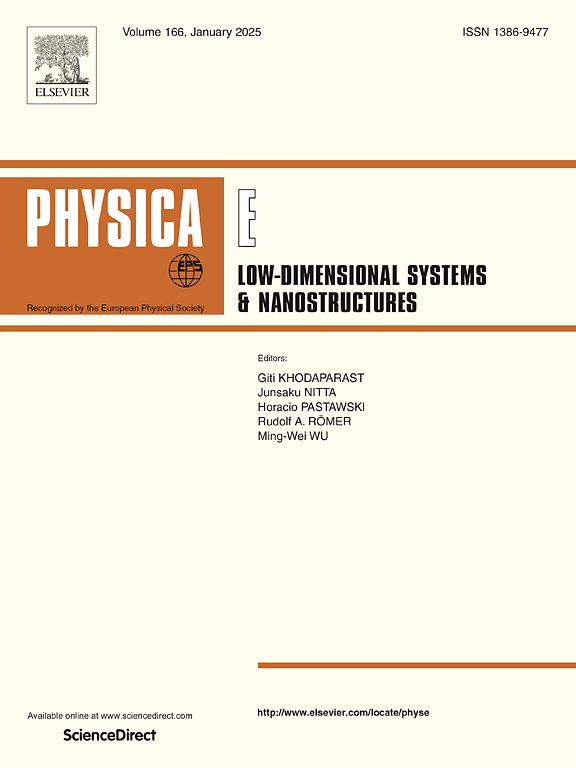Structural, vibrational, elastic, and electronic properties of MgO cluster-assembled monolayers
IF 2.9
3区 物理与天体物理
Q3 NANOSCIENCE & NANOTECHNOLOGY
Physica E-low-dimensional Systems & Nanostructures
Pub Date : 2025-04-17
DOI:10.1016/j.physe.2025.116275
引用次数: 0
Abstract
Atomic-thin two-dimensional (2D) cluster-assembled metal oxide monolayers have been pursued as a rapidly emerging class of 2D materials with unprecedented properties and potential for versatile applications. Using stable Mg6O6 clusters as building blocks, here, we established two new MgO monolayers (namely g-MgO and r-MgO) that completely differ from the known phases, and explored their growth pattern based on cluster assemblies, structural, vibrational, elastic, and electronic properties by exploiting density functional theory (DFT) calculations. Phonon dispersion calculations reveal both monolayers are dynamically stable. The g-MgO and r-MgO monolayers retain structural integrity at 1200 and 1000 K, respectively. Both monolayers have completely different Raman spectra with unique characters, enabling them to be easily identified them in experiments. The calculated in-plane stiffness and Poisson ratio of g-MgO are 75.69 N/m and 0.40, while that of r-MgO are 62.34 (33.87) N/m and 0.97 (0.53), respectively, revealing the isotropic and anisotropic mechanical response for g-MgO and r-MgO monolayers. The g-MgO (r-MgO) monolayer has direct (indirect) semiconducting properties with a wide bandgap of 4.53 (4.64) eV from HSE06 functional and possesses outstandingly high carrier mobilities (all >2.40 × 103 cm2 V−1 s−1), offering promising potential in advanced electronic and photoelectronic applications.

MgO团簇组装单层膜的结构、振动、弹性和电子特性
原子薄二维(2D)簇组装金属氧化物单层作为一种快速兴起的二维材料,具有前所未有的性能和广泛应用的潜力。本文以稳定的Mg6O6团簇为基础,建立了两种与已知相完全不同的新型MgO单层(即g-MgO和r-MgO),并利用密度泛函理论(DFT)计算,基于团簇组装、结构、振动、弹性和电子性质,探索了它们的生长模式。声子色散计算表明这两种单层膜都是动态稳定的。g-MgO和r-MgO单层膜分别在1200和1000 K下保持结构完整性。这两种单分子膜具有完全不同的拉曼光谱,具有独特的特征,使得它们在实验中很容易被识别。g-MgO的面内刚度和泊松比分别为75.69 N/m和0.40,r-MgO的面内刚度和泊松比分别为62.34 (33.87)N/m和0.97(0.53),揭示了g-MgO和r-MgO单层的各向同性和各向异性力学响应。g-MgO (r-MgO)单层具有直接(间接)半导体性质,从HSE06功能具有4.53 (4.64)eV的宽带隙,并具有非常高的载流子迁移率(所有>;2.40 × 103 cm2 V−1 s−1),在先进电子和光电子应用中具有广阔的潜力。
本文章由计算机程序翻译,如有差异,请以英文原文为准。
求助全文
约1分钟内获得全文
求助全文
来源期刊
CiteScore
7.30
自引率
6.10%
发文量
356
审稿时长
65 days
期刊介绍:
Physica E: Low-dimensional systems and nanostructures contains papers and invited review articles on the fundamental and applied aspects of physics in low-dimensional electron systems, in semiconductor heterostructures, oxide interfaces, quantum wells and superlattices, quantum wires and dots, novel quantum states of matter such as topological insulators, and Weyl semimetals.
Both theoretical and experimental contributions are invited. Topics suitable for publication in this journal include spin related phenomena, optical and transport properties, many-body effects, integer and fractional quantum Hall effects, quantum spin Hall effect, single electron effects and devices, Majorana fermions, and other novel phenomena.
Keywords:
• topological insulators/superconductors, majorana fermions, Wyel semimetals;
• quantum and neuromorphic computing/quantum information physics and devices based on low dimensional systems;
• layered superconductivity, low dimensional systems with superconducting proximity effect;
• 2D materials such as transition metal dichalcogenides;
• oxide heterostructures including ZnO, SrTiO3 etc;
• carbon nanostructures (graphene, carbon nanotubes, diamond NV center, etc.)
• quantum wells and superlattices;
• quantum Hall effect, quantum spin Hall effect, quantum anomalous Hall effect;
• optical- and phonons-related phenomena;
• magnetic-semiconductor structures;
• charge/spin-, magnon-, skyrmion-, Cooper pair- and majorana fermion- transport and tunneling;
• ultra-fast nonlinear optical phenomena;
• novel devices and applications (such as high performance sensor, solar cell, etc);
• novel growth and fabrication techniques for nanostructures

 求助内容:
求助内容: 应助结果提醒方式:
应助结果提醒方式:


